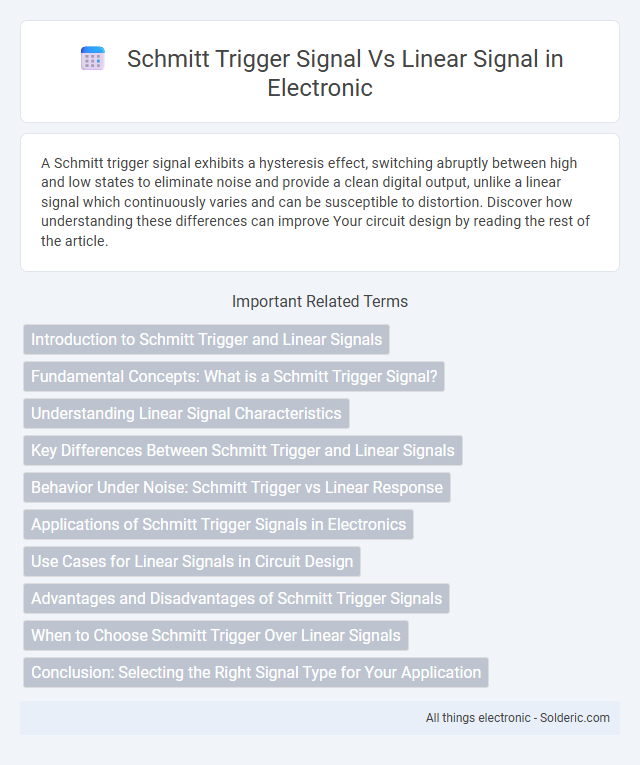A Schmitt trigger signal exhibits a hysteresis effect, switching abruptly between high and low states to eliminate noise and provide a clean digital output, unlike a linear signal which continuously varies and can be susceptible to distortion. Discover how understanding these differences can improve Your circuit design by reading the rest of the article.
Comparison Table
| Feature | Schmitt Trigger Signal | Linear Signal |
|---|---|---|
| Signal Type | Digital, hysteresis-based | Analog, continuous |
| Operation | Switches sharply at defined thresholds | Varies proportionally with input |
| Noise Immunity | High, reduces false triggering | Low, susceptible to noise |
| Thresholds | Two distinct thresholds (upper and lower) | Single, variable threshold |
| Output Levels | Discrete levels: typically High or Low | Continuous range of values |
| Application | Debouncing, waveform shaping, digital circuits | Signal amplification, filtering, modulation |
| Response | Fast switching with hysteresis effect | Linear and proportional response |
Introduction to Schmitt Trigger and Linear Signals
Schmitt trigger signals are digital waveforms characterized by hysteresis, allowing them to switch cleanly between high and low states, effectively filtering out noise and ensuring stable transitions. Linear signals vary continuously in amplitude and are prone to distortion and noise, making them less reliable for precise switching tasks. Schmitt triggers convert noisy analog inputs into stable digital outputs, contrasting with the gradual, continuous nature of linear signal variations.
Fundamental Concepts: What is a Schmitt Trigger Signal?
A Schmitt trigger signal is characterized by its hysteresis behavior, which means it switches between high and low states at different threshold voltages, providing noise immunity and stable output in the presence of slowly varying or noisy input signals. Unlike linear signals that vary continuously and proportionally with input, Schmitt trigger outputs are digital-like, producing sharp transitions once the input crosses defined upper or lower thresholds. This unique property makes Schmitt triggers essential in waveform shaping, signal conditioning, and eliminating false triggering in electronic circuits.
Understanding Linear Signal Characteristics
Linear signals maintain a proportional relationship between input and output, characterized by continuous amplitude variations and predictable behavior across a range of frequencies. These signals preserve waveform integrity and are essential in analog circuits where precise signal representation is critical, such as audio processing and instrumentation. Understanding linear signal characteristics helps optimize system performance, minimize distortion, and ensure accurate signal analysis.
Key Differences Between Schmitt Trigger and Linear Signals
Schmitt trigger signals exhibit hysteresis with distinct threshold voltages causing abrupt switching between high and low states, while linear signals vary continuously and proportionally with input. The Schmitt trigger enhances noise immunity and provides a clean digital output by preventing signal jitter near switching points, unlike linear signals, which can be susceptible to noise and distortion. Your application benefits from Schmitt triggers in digital circuits requiring stable state transitions, whereas linear signals are preferred in analog processing where proportional response is essential.
Behavior Under Noise: Schmitt Trigger vs Linear Response
Schmitt trigger signals exhibit superior noise immunity compared to linear signals by employing hysteresis to reject small fluctuations and prevent erratic switching. Linear responses amplify noise along with the input, resulting in less stable output and increased susceptibility to signal distortion. Your choice of a Schmitt trigger ensures cleaner digital transitions in noisy environments, enhancing reliability and signal integrity.
Applications of Schmitt Trigger Signals in Electronics
Schmitt trigger signals are widely used in electronics for noise immunity and signal conditioning, transforming noisy or slowly varying input signals into clean, fast digital outputs. Applications include debouncing mechanical switches, waveform shaping, and interface circuits in microcontrollers where clean, stable signals are crucial. Using a Schmitt trigger enhances your circuit's reliability by preventing false triggering caused by signal fluctuations.
Use Cases for Linear Signals in Circuit Design
Linear signals are essential in analog circuit design where continuous and proportional voltage or current variations are required, such as in audio amplification, sensor signal processing, and analog modulation. These signals enable precise control and accurate representation of real-world phenomena, facilitating smooth feedback loops and linear response in operational amplifiers and filters. Unlike Schmitt trigger signals, which are ideal for digital switching and noise immunity, linear signals maintain fidelity in applications demanding fine gradations and minimal distortion.
Advantages and Disadvantages of Schmitt Trigger Signals
Schmitt trigger signals provide noise immunity and clean switching by converting noisy or slowly varying inputs into sharp, stable output waveforms, which enhances circuit reliability especially in digital applications. Their hysteresis characteristic prevents false triggering, but they can introduce signal distortion and are less suitable for linear amplification tasks compared to linear signals. Your choice between Schmitt trigger and linear signals depends on whether noise resistance or signal fidelity is prioritized in your specific application.
When to Choose Schmitt Trigger Over Linear Signals
Schmitt trigger signals excel in noisy environments where clean, stable digital transitions are crucial, offering hysteresis to prevent false triggering from fluctuations. Linear signals are ideal for applications requiring precise analog information and smooth variations without abrupt switching. You should choose a Schmitt trigger when your circuit demands noise immunity and sharp, well-defined switching thresholds rather than continuous, linear response.
Conclusion: Selecting the Right Signal Type for Your Application
Schmitt trigger signals offer noise immunity and clear digital transitions, making them ideal for applications requiring stable switching and hysteresis, such as debouncing or waveform shaping. Linear signals provide continuous amplitude variations, suited for analog processing, precise measurements, and real-time monitoring where signal fidelity is crucial. Choosing between Schmitt trigger and linear signals depends on the need for noise immunity and digital clarity versus accurate amplitude representation and analog precision.
Schmitt trigger signal vs linear signal Infographic

 solderic.com
solderic.com